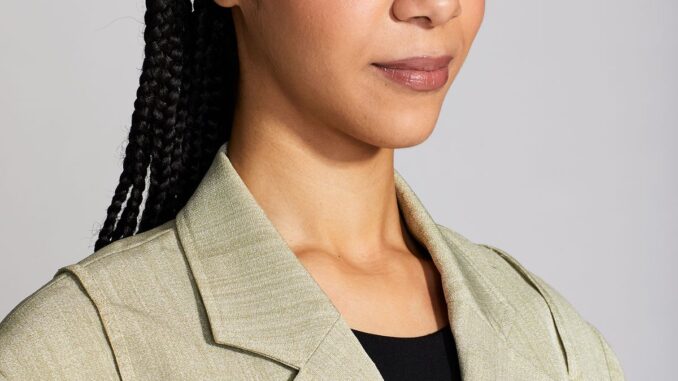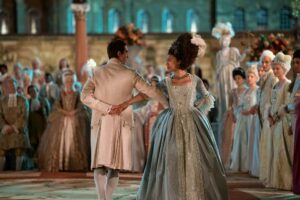
The British actress opens up about the “brazen” Bridgerton prequel—and why she’s grateful the show isn’t afraid to tackle race-related issues.
In the first episode of Queen Charlotte: A Bridgerton Story, a young Queen Charlotte, then Sophia Charlotte of Mecklenburg-Strelitz, is presented to Princess Augusta for the first time. Augusta (a steely Michelle Fairley, of Game of Thrones fame) circles Charlotte (newcomer India Amarteifio, perfectly cast) menacingly as she inspects her future daughter-in-law. After asking about her teeth and hands, and commenting on her child-bearing hips, Augusta licks her fingers and reaches out to wipe Charlotte’s skin. Charlotte, offended, stares at her, but says nothing.
This is far from the “race-conscious” approach Bridgerton took to its storytelling, where the racial identities of characters like Simon, the Duke of Hastings (Regé-Jean Page) or Kate Sharma (Simone Ashley) are not a critical part of them storylines. After reading that scene in her script, star India Amarteifio, a 21-year-old Black British actress, wanted to tell creator Shonda Rhimes, “Thank you for bringing this to light.”
Queen Charlotte, out today, is a prequel meant to give context to the world of Bridgerton; it’s intended both for viewers who are existing fans of the original series, and those who haven’t watched Bridgerton. The show, Amarteifio tells Town & Country, “explores so many different journeys that you just don’t expect at all; things that you’re like, ‘Is she about to say that? Oh my gosh, she is!’ Or, ‘Are they about to refer to her? Oh my gosh, they are.’ We’re not shy.” Hot-button issues, like ones related to race, Amarteifio continues, are ‘spoken about in direct [terms]; it will be written out for you.’ It’s very brazen and quite risky, but that’s exciting—and how cool to be a part of.”
Augusta wiping Charlotte’s skin is just one of many scenes where Charlotte’s Blackness factors into the plot; the show seeks to explain how the world of Bridgerton came to be, thanks to the marriage of Charlotte and George. In doing so, Queen Charlotte feels more responsive, in a way, to modern-day issues of race and racism. Amarteifio is glad they’re showing these types of racial microgressions, plain and simple, in Queen Charlotte. “How society treats Black women is still not where we need to be at, and the fact that Shonda’s making it such a pivotal theme and idea in the show is going to speak to a lot of people who that still happens to,” says Amarteifio . “It’s horrible to watch and it’s uncomfortable. But again, we don’t make change unless we create conversation. This is going to create conversation—one way or another.”

Filming that particular scene, Amarteifio tells T&C, was a “weird” experience, but Charlotte’s emotions were easy to access. “It wasn’t difficult to feel angry, or to feel any kind of disgust toward her, because her actions are completely immoral and dehumanizing,” she says of Princess Augusta’s behavior. “I can’t imagine what it’s like for Michelle to do that. She’s just the loveliest, most accepting human being ever.”
Intentionally or not, Augusta’s reaction to Charlotte’s skin mirrors conversations taking place within the modern-day British royal family. In a bombshell interview with Oprah in 2021, Meghan Markle revealed there were “concerns and conversations” over how dark Archie’s skin may have been when he was born. “There was concern about his skin color,” Prince Harry said earlier this year, although he added he didn’t think his family was racist. Within just the last few weeks, reports surfaced of letters exchanging between King Charles and Meghan about unconscious bias.
Amarteifio says she wasn’t thinking too much about the Duke and Duchess of Sussex as she worked on Queen Charlotte, but calls it “crazy” that “we’re able to draw similar parallels to things that are happening in real life to a show that’s set 400 years ago.” She adds, “The fact that we’re still having the same conversations just shows how far we’ve got to go.”
Although Meghan and Harry were not top of mind for her, the actress admitted she did binge-watch Netflix’s The Crown “to get an understanding of what it’s like—having all that attention and the fame and people around you all the time.” She continued, “It was really important for me to put it into context of the modern day English monarchy, but it feels weird. I never really looked at the monarchy as anything more than tourist attraction for people outside Britain to come and see them. But I understand now how important they are to society and to England.”
Despite not thinking about the modern-day royals, Amarteifio instinctively understood that as a Black woman, playing a character like Queen Charlotte in the Bridgerton-verse is a big deal.
